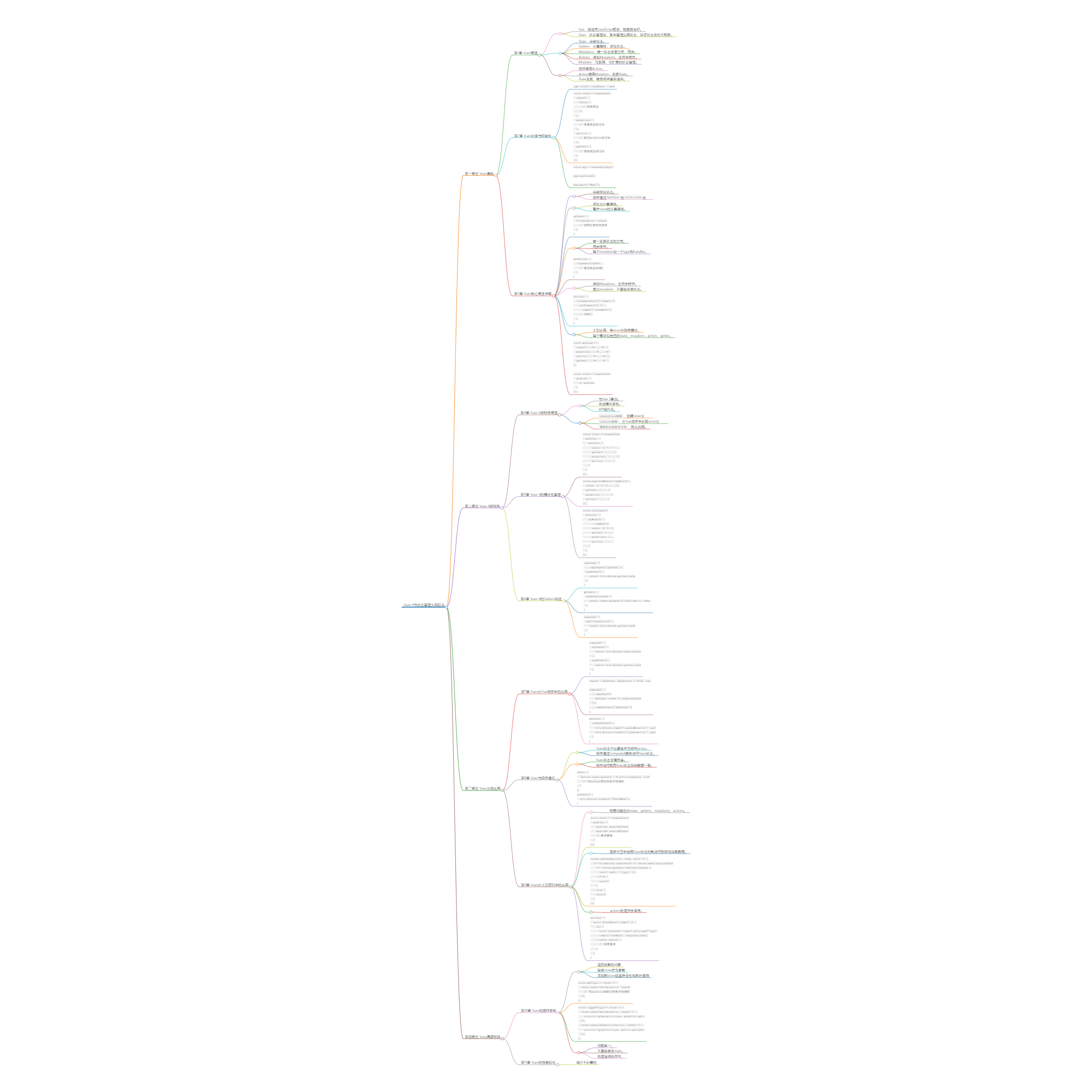title: Vuex 4与状态管理实战指南
date: 2024/6/6
updated: 2024/6/6
excerpt:
这篇文章介绍了使用Vuex进行Vue应用状态管理的最佳实践,包括为何需要状态管理,Vuex的核心概念如store、actions、mutations和getters,以及如何处理异步操作和模块化组织状态。通过例子展示了如何动态注册模块,以实现可复用和可扩展的状态管理解决方案。
categories:
tags:

Vue是一个渐进式JavaScript框架,它被设计为易于上手同时也能够强大到驱动复杂的单页应用(SPA)。Vue的核心库只关注视图层,不仅易于学习,而且容易与其他库或现有项目整合。Vuex是一个专门为Vue.js应用程序开发的状态管理模式和库。它采用集中式存储管理应用的所有组件的状态,并以相应的规则保证状态以一种可预测的方式发生变化。
Vuex与Vue的关系是互补的,Vue负责视图层的渲染,而Vuex则负责管理应用的状态。在没有Vuex的情况下,Vue组件之间的状态管理可能会变得复杂且难以维护,Vuex的出现解决了这一问题。
Vuex的核心概念包括以下几个部分:
Vuex的工作流程通常如下:
dispatch调用一个action。Vuex可以通过npm进行安装:
npm install vuex@next --save # 安装Vuex 4版本
复制创建Vuex Store通常需要定义一个store对象,并在其中包含state、mutations、actions、getters等:
import { createStore } from 'vuex';
const store = createStore({
state() {
return {
// 初始状态
};
},
mutations: {
// 变更状态的方法
},
actions: {
// 提交mutation的方法
},
getters: {
// 获取状态的方法
}
});
复制在Vue应用中集成Vuex,需要在Vue实例的创建过程中将store实例作为插件使用:
import { createApp } from 'vue';
import App from './App.vue';
import store from './store';
const app = createApp(App);
app.use(store);
app.mount('#app');
复制State是Vuex store的核心,它存储了所有组件的状态。组件可以通过mapState辅助函数或store.state直接访问状态。
归档 | cmdragon's Blog
Getters可以让我们从store的state中派生出一些状态,例如过滤列表、计数器的值等。它们可以被看作是store的计算属性。
getters: {
filteredList: (state) => {
// 返回过滤后的列表
}
}
复制Mutations是更改Vuex store中状态的唯一方式,它们是同步的,每个mutation都有一个字符串类型的事件类型(type)和一个回调函数(handler)。
mutations: {
increment(state) {
// 更改状态的逻辑
}
}
复制Actions类似于mutations,但它们支持异步操作。Action提交的是mutation,而不是直接变更状态。
actions: {
incrementAsync({ commit }) {
setTimeout(() => {
commit('increment');
}, 1000);
}
}
复制对于大型应用,Vuex允许将store分割成模块。每个模块拥有自己的state、mutation、action、getter,使得代码结构更清晰,易于管理。
const moduleA = {
state() { /* ... */ },
mutations: { /* ... */ },
actions: { /* ... */ },
getters: { /* ... */ }
};
const store = createStore({
modules: {
a: moduleA
}
});
复制Vuex 4是Vuex的最新版本,它与Vue 3兼容,并带来了一些重要的改进:
Vuex 4的API变化主要包括:
new Vuex.Store。在Vuex 4中,模块的注册更加简单,并且默认启用了自动命名空间。这意味着每个模块都有自己的命名空间,可以避免不同模块之间的命名冲突。
const store = createStore({
modules: {
account: {
state: () => ({ ... }),
getters: { ... },
mutations: { ... },
actions: { ... }
}
}
});
复制Vuex 4支持动态注册模块,这使得模块的加载更加灵活。
store.registerModule('myModule', {
state: () => ({ ... }),
getters: { ... },
mutations: { ... },
actions: { ... }
});
复制Vuex 4允许对现有模块进行重写或合并,这在需要更新或扩展模块时非常有用。
store.hotUpdate({
modules: {
myModule: {
...myModule,
state: () => ({ ... }),
getters: { ... },
mutations: { ... },
actions: { ... }
}
}
});
复制在Vuex 4中,可以直接通过store实例访问getters,而不需要使用mapGetters辅助函数。
computed: {
...mapState(['myState']),
myGetter() {
return this.$store.getters.myGetter;
}
}
复制Vuex 4简化了使用getters进行派生状态的过程,使得代码更加简洁。
getters: {
myGetter(state) {
return state.myState.filter(item => item.active);
}
}
复制在组件中使用时,可以直接访问:
computed: {
myFilteredList() {
return this.$store.getters.myGetter;
}
}
复制这些改进使得Vuex 4在处理复杂状态管理时更加高效和易于维护。
在Vue组件中,可以通过this.$store.state来访问store中的状态,通过this.$store.getters来访问getters。
computed: {
// 直接访问state
myState() {
return this.$store.state.myState;
},
// 直接访问getter
myGetter() {
return this.$store.getters.myGetter;
}
}
复制为了简化组件中对store的访问,可以使用mapState和mapGetters辅助函数。
import { mapState, mapGetters } from 'vuex';
computed: {
// 使用mapState
...mapState({
myState: state => state.myState
}),
// 使用mapGetters
...mapGetters(['myGetter'])
}
复制在组件中,可以使用this.$store.dispatch来调用actions,使用this.$store.commit来调用mutations。
methods: {
updateState() {
// 调用mutation
this.$store.commit('updateMutation', payload);
// 调用action
this.$store.dispatch('updateAction', payload);
}
}
复制Vuex的状态不应该直接作为组件的props,因为props通常用于父组件向子组件传递数据。如果需要在组件中使用Vuex状态,应该通过computed属性来访问。
AD:漫画首页
Vuex的状态是全局的,可以被多个组件共享。组件间通过访问相同的Vuex状态来保持数据的一致性。
组件的生命周期钩子可以用来监听Vuex状态的变化,并执行相应的操作。
watch: {
'$store.state.myState': function(newValue, oldValue) {
// 当myState变化时执行的操作
}
},
created() {
// 组件创建时获取数据
this.$store.dispatch('fetchData');
}
复制在大型项目中,Vuex的状态结构设计非常重要。通常建议按照功能模块来划分state、getters、mutations和actions。
const store = createStore({
modules: {
moduleA: moduleAState,
moduleB: moduleBState,
// 更多模块
}
});
复制在Vue项目中,经常需要结合Vuex和Vue Router来管理路由状态。可以在路由守卫中使用Vuex状态来控制访问权限或加载必要的数据。
router.beforeEach((to, from, next) => {
if (to.matched.some(record => record.meta.requiresAuth)) {
if (!store.getters.isAuthenticated) {
next({ path: '/login' });
} else {
next();
}
} else {
next();
}
});
复制Vuex经常与后端服务器进行交互,通过actions来处理异步请求。
actions: {
async fetchData({ commit }) {
try {
const response = await axios.get('/api/data');
commit('setData', response.data);
} catch (error) {
// 处理错误
}
}
}
复制在大型项目中,合理地使用Vuex可以极大地提高项目的可维护性和扩展性。
Vuex插件是一个返回函数的对象,这个函数接收store作为参数。插件可以在store创建之后被添加到store中,用于监听store的变化或执行一些额外的逻辑。
const myPlugin = store => {
store.subscribe((mutation, state) => {
// 当mutation被提交时执行的操作
});
};
复制创建自定义插件时,你可以利用store.subscribe来监听mutation的变化,或者使用store.subscribeAction来监听action的变化。
const loggerPlugin = store => {
store.subscribe((mutation, state) => {
console.log(mutation.type, mutation.payload);
});
store.subscribeAction((action, state) => {
console.log(action.type, action.payload);
});
};
复制使用Vuex插件时,以下是一些最佳实践:
在大型应用中,Vuex的状态树可能会变得非常庞大,这可能会影响到应用的性能。以下是一些性能考量的方面:
Vuex状态树的扁平化是指将嵌套的状态结构转换为扁平的结构,这有助于减少组件的计算负担。
// 假设原始状态树
const state = {
user: {
id: 1,
name: '张三'
},
settings: {
theme: 'dark'
}
};
// 扁平化的状态
const flatState = {
userId: state.user.id,
userName: state.user.name,
settingsTheme: state.settings.theme
};
复制为了防止页面刷新导致Vuex状态丢失,可以使用持久化和缓存机制。
// 使用localStorage进行持久化
const saveStateToLocalStorage = state => {
localStorage.setItem('vuexState', JSON.stringify(state));
};
const loadStateFromLocalStorage = () => {
const state = localStorage.getItem('vuexState');
return state ? JSON.parse(state) : undefined;
};
复制在实现持久化和缓存时,需要考虑数据的安全性和性能,避免敏感数据的泄露和性能的下降。
Vue 3带来了多项新特性,包括但不限于:
在Vue 3中使用Vuex与Vue 2类似,但需要确保使用与Vue 3兼容的Vuex版本。在Vue 3中,你可以通过app.use(store)来安装Vuex。
import { createApp } from 'vue';
import { createStore } from 'vuex';
// 创建一个新的store实例
const store = createStore({ /* ... */ });
// 创建Vue应用实例并使用store
const app = createApp({ /* ... */ });
app.use(store);
app.mount('#app');
复制在Vue 3中,可以使用组合式API来使用Vuex。以下是如何在组件中使用Vuex的状态和操作:
import { computed } from 'vue';
import { useStore } from 'vuex';
export default {
setup() {
const store = useStore();
// 使用store.state和store.getters
const count = computed(() => store.state.count);
const doubleCount = computed(() => store.getters.doubleCount);
// 使用store.dispatch和store.commit
function increment() {
store.dispatch('increment');
}
function decrement() {
store.commit('decrement');
}
return { count, doubleCount, increment, decrement };
}
};
复制虽然Vuex是为Vue设计的,但理论上也可以在React应用中使用。然而,通常推荐使用更符合React生态的数据流管理库,如Redux。如果需要在React中使用Vuex,可以通过创建相应的包装器和桥接代码来实现。
AD:专业搜索引擎
Vuex不是为Angular设计的,Angular有自己的状态管理库——NgRx。不过,如果你想在Angular项目中使用Vuex,需要创建一个服务来模拟Vuex的核心功能,但这通常不是一个好的实践。
在跨框架项目中使用Vuex是非常不常见的,因为每个框架都有自己的状态管理解决方案。如果确实需要在跨框架的项目中使用Vuex,可能需要创建一个统一的状态管理层,然后为每个框架提供适配器来与这个状态管理层交互。这种做法通常很复杂,并且可能带来不必要的性能和维护成本。
在实际开发中,推荐使用每个框架对应的状态管理解决方案,例如在React中使用Redux,在Vue中使用Vuex,在Angular中使用NgRx。这样可以更好地利用每个框架的特性和生态。
在项目中,Vuex的目录结构应当清晰明确,以下是一个推荐的目录结构示例:
src/
|-- store/
|-- index.js # Vuex的入口文件,用于创建store实例
|-- modules/ # 存放各个Vuex模块
|-- user.js # 用户模块
|-- products.js # 产品模块
|-- getters.js # 公共getters
|-- actions.js # 公共actions
|-- mutations.js # 公共mutations
复制模块的划分应遵循以下原则:
状态的命名应遵循以下规范:
对Vuex状态进行单元测试时,可以使用Vue Test Utils和Jest等测试工具。以下是一个简单的测试示例:
import { createStore } from 'vuex';
const store = createStore({
state: {
count: 0
},
mutations: {
increment(state) {
state.count++;
}
}
});
describe('Vuex state', () => {
it('mutations should increment count', () => {
store.commit('increment');
expect(store.state.count).toBe(1);
});
});
复制。AD:首页 | 一个覆盖广泛主题工具的高效在线平台
集成测试通常涉及组件和Vuex store的交互。以下是一个集成测试的示例:
import { mount } from '@vue/test-utils';
import MyComponent from '@/components/MyComponent.vue';
import { createStore } from 'vuex';
const store = createStore({
state: {
count: 0
},
mutations: {
increment(state) {
state.count++;
}
}
});
const wrapper = mount(MyComponent, {
global: {
plugins: [store]
}
});
// 触发组件中的方法,并断言状态的变化
wrapper.find('button').trigger('click');
expect(wrapper.vm.$store.state.count).toBe(1);
复制为了维护Vuex代码,以下是一些最佳实践:
在迭代管理Vuex状态时:
当升级Vuex版本时:
以下是一些Vuex学习的资源列表,可以帮助开发者更好地理解和掌握Vuex:
以下是关于Vuex的一些常见问题及其解答:
以下是Vuex的一些主要版本更新日志摘要:
具体每个版本的详细更新内容,可以查看Vuex的官方GitHub仓库中的Release Notes。